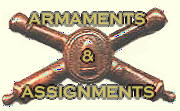|
Enlargements on the CD-Rom only |
Work on the 12" long range barbette guns known as Battery Smith 1 and 2 began September 1918 and was completed June 1921. The cost of the battery and magazine was $148,105.32 or more than 2 million in today's dollars. (Source: Report of Completed Works dated November 1,1921.) Btty Smith 1 and Smith 2 (the latter known as Btty Hearn since 1937) are each Coastal Defense Gun Model 1898, and are 340 yards distant from each other. As with the other 10 and 12 inch Mortars and guns, they were built at the Watervliet Arsenal in Watervliet, New York. They were capable of firing both Armor Piercing and High Explosive projectiles weighing over 1000 pounds up to a range of 17 miles (29,000 yards.)
Although the guns could traverse almost 360 degrees the normal sector of fire was
about 90 degrees, as evidenced by the placement of aiming stakes planted on the edge of
the Smith concrete pad by some traveller who obviously understood. This would overlap with
the sector of fire of the gun to either side of it.
In their last days on Corregidor, the Americans attempted to destroy their weapons by firing them with the recoil cylinders drained of oil an with the barrels jammed - standard coast artillery doctrine for destroying a weapon. Smith is still magnificently unpainted and bears the patina of rust well. The barrel casing is splattered with shrapnel scars, and there is still shrapnel to be picked up in the immediate vicinity - if you don't mind looking through the long grass.
Battery Smith can be found by following the trail which leads off the tour tram-turning pad near Battery Grubbs. Follow the trail downhill a few hundred yards. When exploring the tunnel, be aware that it's on more than one level, and watch for the the trapdoors in the floor, which lead down to lower levels. These levels have been filled over the years by rocks and soil, probably for safety reasons.
|
Battery Smith had three guns: Smith number 1, Smith number 2 and a 155mm GPF. I believe that the 155mm gun was Battery Monja, but I have never been able to confirm it. Smith number 1 and number 2 were so far apart that they operated tactically as two separate batteries. Thus, they were split up into two batteries. Battery Monja was transferred to the 92d Coast Artillery and in 1941 & 1942 was manned by Battery "G".
|
|
|
|
Corregidor has a habit of teaching us that "the more you get to know
about the island, the less you realize you know." Battery Hearn is a
good example. The 1936 Corps of Engineers map clearly shows two twelve-inch
Batteries named Smith 1 and Smith 2.
Before the name change the two twelve-inch batteries were popularly known as "The Smith Brothers", a play on the name of the then well-loved confectionary, Smith Brothers' Cough Drops. Popular lore had it that the brothers names were "Trade" and "Mark", an amusing reading of their product labels.
The entry on the renaming of the battery was added in a longhand note at the bottom of the document.
|
|
Smith Tunnel!
|
Bill Calhoun recalls "The 1st platoon was given the mission of capturing one of the Batteries far out on the western end of the island. I now know it as Battery Smith." (See "THE NIGHT OF A THOUSAND HOURS" )
|
|
From the Moore Report:
DAVIS,
Capt., Thomas W. Commanding Btry H, 59th CA-
Btry Hearn received one bomb hit 7 January placing it out of action
for about four hours. It was not fired until the night | |
|
One of Smith's huge pair of recoil tubes has been cut off.
|
RUTHERFORD, |
|
PALPALATOC,
Pfc., Alberto, Btry Gm 91st CA (PS) – The base ring at Btry
Smith was broken by demolition. The emplacement was in bad shape but the tunnel
was open. All plotting room equipment and the telephones were destroyed. There
was only .50 calibre ammunition in this vicinity. They (the Japanese) made us pile up the
ammunition and sort out the good from the damaged.
Brass cartridge cases of rounds we said were no good were collected for
shipment to |
|







 By
1937, the guns were manned, organised and employed as separate batteries.
Smith was manned by Battery F, 59th C.A. and it was decided to rename
Smith 2 in honor of
the late Brigadier Clint C. Hearn, a Harbor Defense Commander.
By
1937, the guns were manned, organised and employed as separate batteries.
Smith was manned by Battery F, 59th C.A. and it was decided to rename
Smith 2 in honor of
the late Brigadier Clint C. Hearn, a Harbor Defense Commander.







